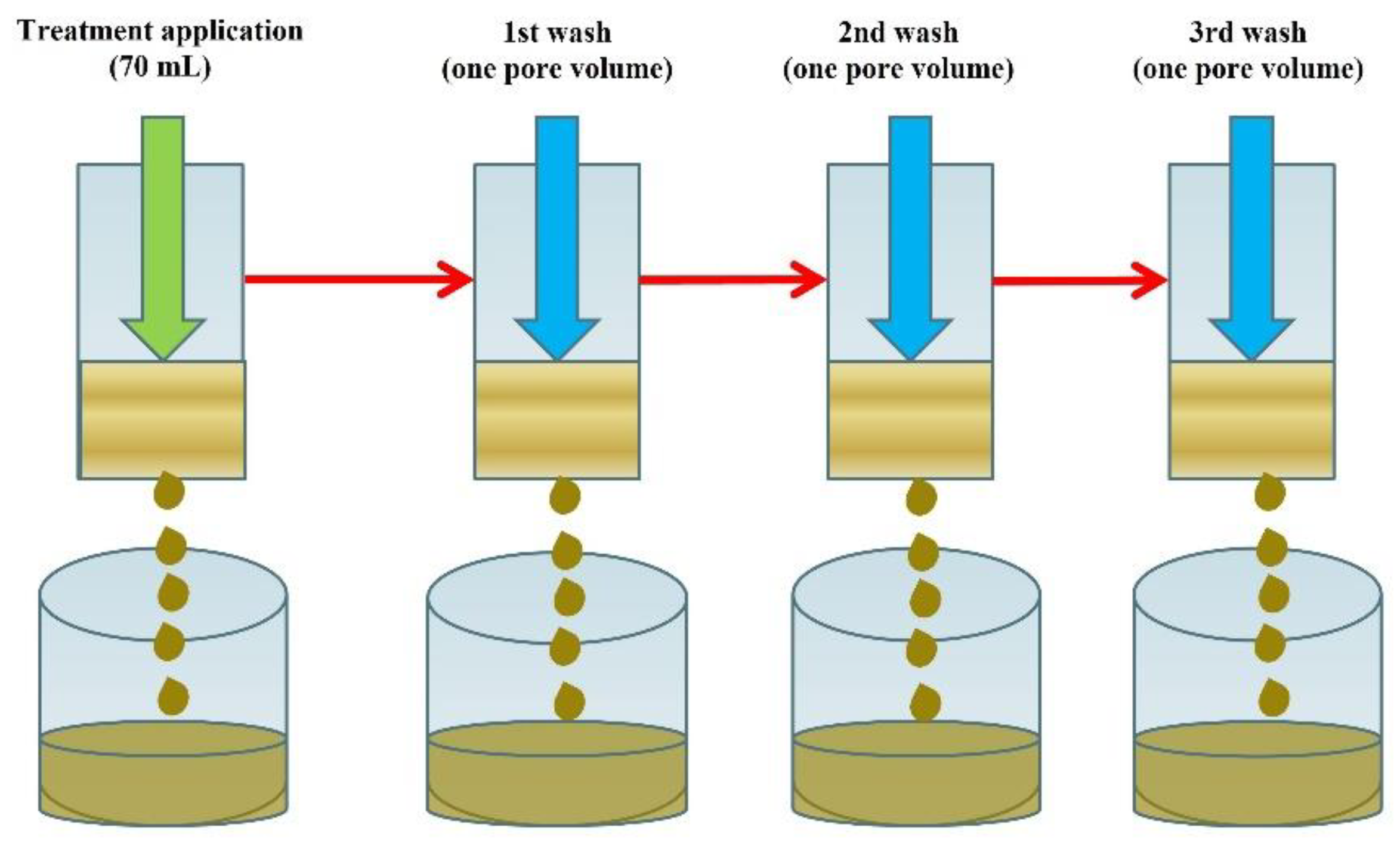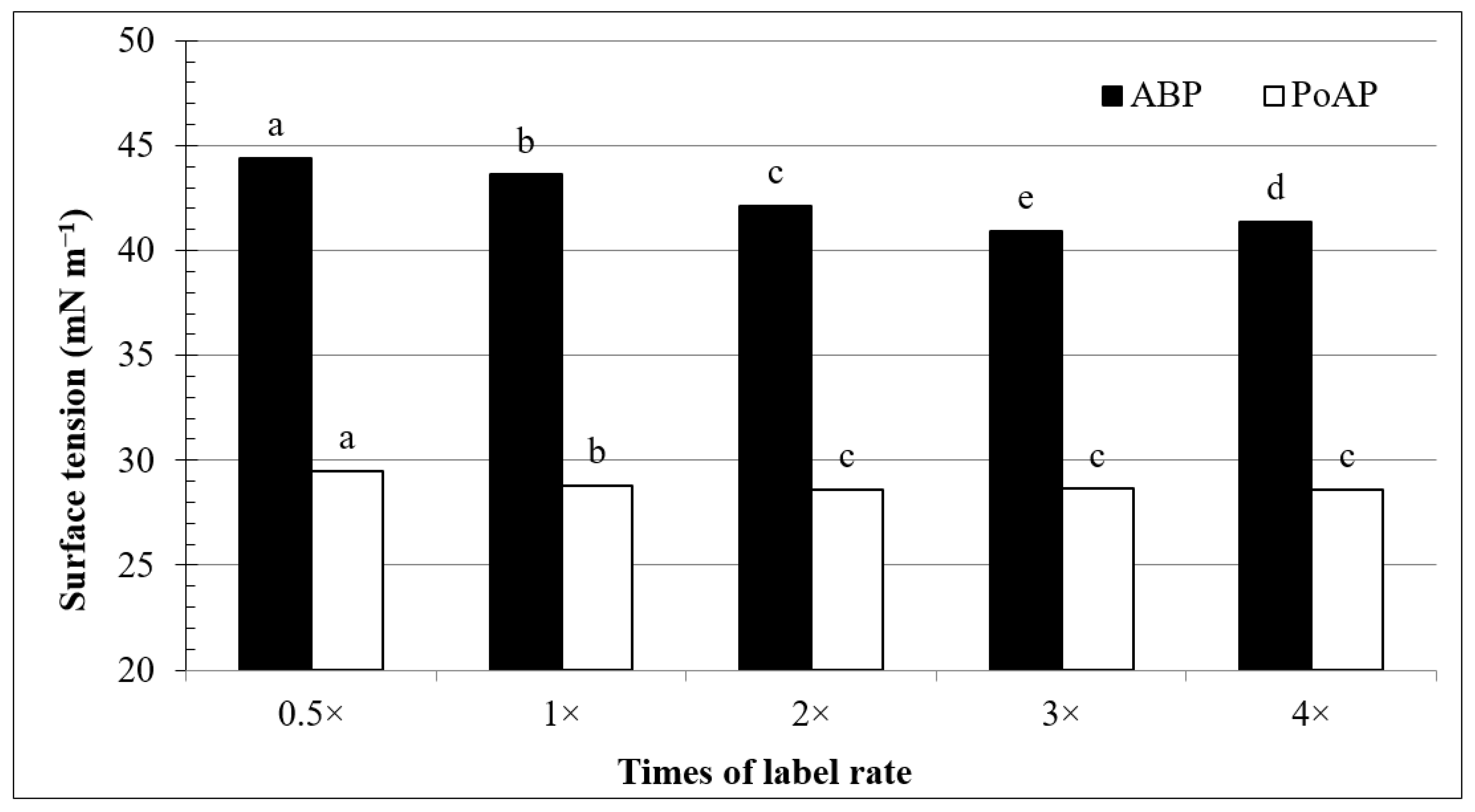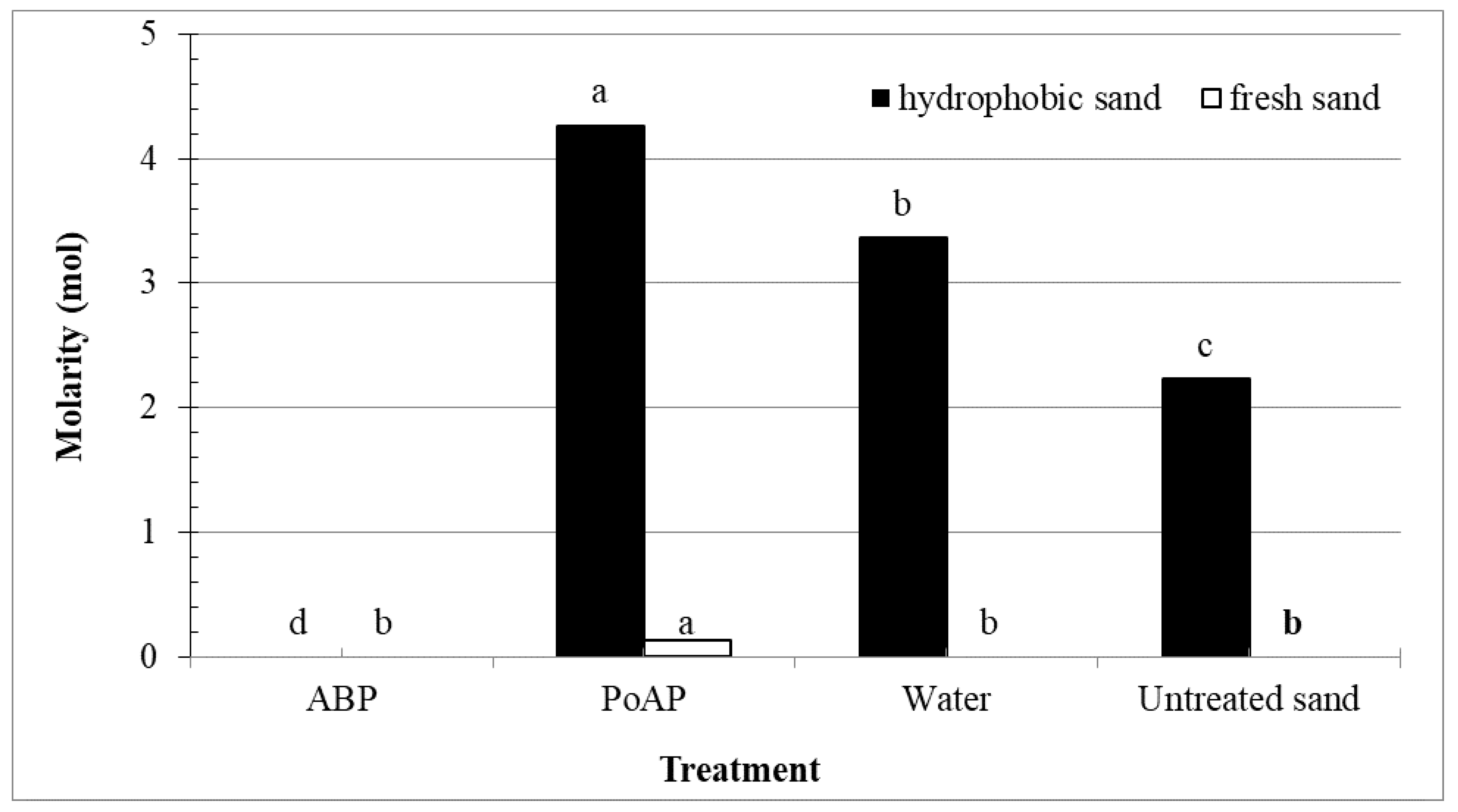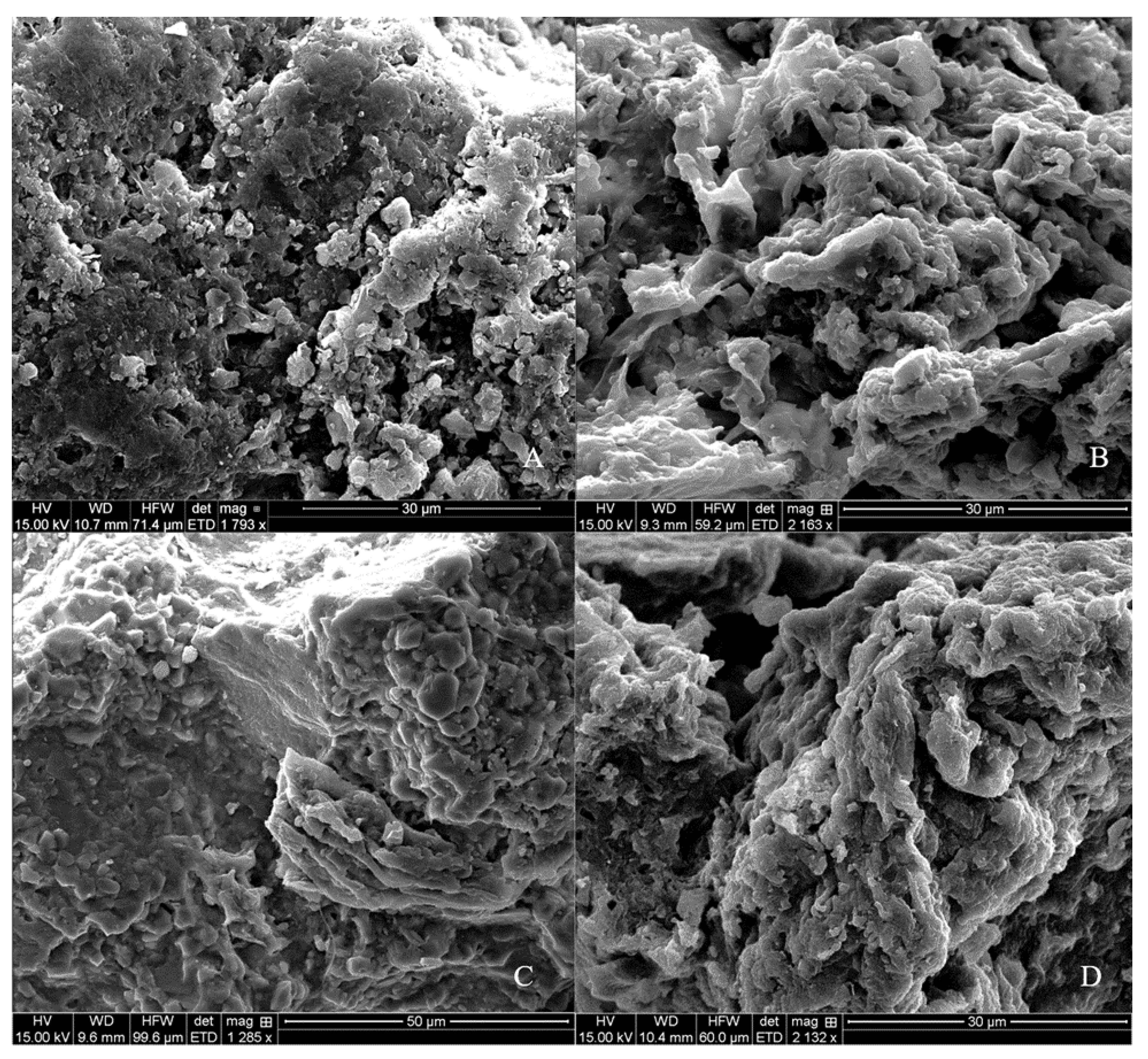Certain Soil Surfactants Could Become a Source of Soil Water Repellency after Repeated Application
Abstract
:1. Introduction
2. Materials and Methods
3. Results and Discussion
3.1. Surface Tension-Concentration Relationship
3.2. Effects on Leachate Volume
3.3. Effects on DOC, POC, and SOC
3.4. Effects on SWR
3.5. Visual Images from SEM Analysis
4. Conclusions
Supplementary Materials
Author Contributions
Funding
Data Availability Statement
Conflicts of Interest
Abbreviation
References
- Doerr, S.H.; Shakesby, R.A.; Walsh, R.P.D. Soil water repellency: Its causes, characteristics and hydro-geomorphological significance. Earth-Sci. Rev. 2000, 51, 33–65. [Google Scholar] [CrossRef]
- Ellies, A.; Hartge, K.H. Change of wetting properties of soils due to different crops and varying time. J. Rural Eng. Dev. 1994, 35, 358–364. [Google Scholar]
- Tucker, K.A.; Karnok, K.J.; Radcliffe, D.E.; Landry, G.; Roncadori, R.W.; Tan, K.H. Localized dry spots as caused by hydrophobic sands on bentgrass greens. Agron. J. 1990, 82, 549–555. [Google Scholar] [CrossRef] [Green Version]
- Wallis, M.G.; Horne, D.J. Soil water repellency. Adv. Soil Sci. 1992, 20, 91–146. [Google Scholar]
- Wilkinson, J.F.; Miller, R.H. Investigation and treatment of localized dry spots on sand golf greens. Agron. J. 1978, 70, 299–304. [Google Scholar] [CrossRef]
- Dekker, L.W.; Oostindie, K.; Kostka, S.J.; Ritsema, C.J. Effects of surfactant treatments on the wettability of a water repellent grass-covered dune sand. Aust. J. Soil Res. 2005, 43, 383–395. [Google Scholar] [CrossRef]
- Olorunfemi, I.E.; Ogunrinde, T.A.; Fasinmirin, J.T. Soil hydrophobicity: An overview. J. Sci. Res. Rep. 2014, 3, 1003–1037. [Google Scholar] [CrossRef]
- Cisar, J.L.; Williams, K.E.; Vivas, H.E.; Haydu, J.J. The occurrence and alleviation by surfactants of soil-water repellency on sand based turfgrass systems. J. Hydrol. 2000, 231, 352–358. [Google Scholar] [CrossRef]
- Song, E.; Pan, X.; Kremer, R.J.; Goyne, K.W.; Anderson, S.H.; Xiong, X. Influence of repeated application of wetting agents on soil water repellency and microbial community. Sustainability 2019, 11, 4505. [Google Scholar] [CrossRef] [Green Version]
- Feeney, D.S.; Crawford, J.W.; Daniell, T.; Hallett, P.D.; Nunan, N.; Ritz, K.; Rivers, M.; Young, I.M. Three-dimensional microorganization of the soil–root–microbe system. Microb. Ecol. 2006, 52, 151–158. [Google Scholar] [CrossRef] [PubMed]
- McGhie, D.A.; Posner, A.M. Water repellence of a heavy-textured Western Australian surface soil. Aust. J. Soil Res. 1980, 18, 309–323. [Google Scholar] [CrossRef]
- McGhie, D.A.; Posner, A.M. The effect of plant top material on the water repellence of fired sands and water repellent soils. Crop Pasture Sci. 1981, 32, 609–620. [Google Scholar] [CrossRef]
- Sun, S.; Inskeep, W.P.; Boyd, S.A. Sorption of nonionic compounds in soil-water systems containing a micelle-forming surfactant. Environ. Sci. Technol. 1995, 29, 903–913. [Google Scholar] [CrossRef] [PubMed]
- De Blas, E.; Rodríguez-Alleres, M.; Almendros, G. Speciation of lipid and humic fractions in soils under pine and eucalyptus forest in northwest Spain and its effect on water repellency. Geoderma 2010, 155, 242–248. [Google Scholar] [CrossRef]
- Franco, C.M.M.; Tate, M.E.; Oades, J.M. Studies on non-wetting sands. I. The role of intrinsic particulate organic-matter in the development of water-repellency in non-wetting sands. Aust. J. Soil Res. 1995, 33, 253–263. [Google Scholar] [CrossRef]
- Graber, E.R.; Tagger, S.; Wallach, R. Role of divalent fatty acid salts in soil water repellency. Soil Sci. Soc. Am. J. 2009, 73, 541–549. [Google Scholar] [CrossRef]
- Mainwaring, K.A.; Morley, C.P.; Doerr, S.H.; Douglas, P.; Llewellyn, C.T.; Llewellyn, G.; Matthews, I.; Stein, B.K. Role of heavy polar organic compounds for water repellency of sandy soils. Environ. Chem. Lett. 2004, 2, 35–39. [Google Scholar] [CrossRef]
- Kern, K.; David, R.; Palmer, R.L.; Comsa, G. Complete wetting on ‘strong’ substrates: Xe/Pt (111). Phys. Rev. Lett. 1986, 56, 2823. [Google Scholar] [CrossRef]
- Cui, X.; Mao, S.; Liu, M.; Yuan, H.; Du, Y. Mechanism of surfactant micelle formation. Langmuir 2008, 24, 10771–10775. [Google Scholar] [CrossRef]
- Song, E.; Goyne, K.W.; Kremer, R.J.; Anderson, S.H.; Xiong, X. Surfactant chemistry effects on organic matter removal from water-repellent sand. Soil Sci. Soc. Am. J. 2018, 85, 1252–1258. [Google Scholar] [CrossRef] [Green Version]
- Urrestarazu, M.; Guillén, C.; Mazuela, P.C.; Carrasco, G. Wetting agent effect on physical properties of new and reused rockwool and coconut coir waste. Sci. Hortic. 2008, 116, 104–108. [Google Scholar] [CrossRef]
- Shen, Y.H. Sorption of non-ionic surfactants to soil: The role of soil mineral composition. Chemosphere 2000, 41, 711–716. [Google Scholar] [CrossRef]
- Sun, Y.; Unestam, T.; Lucas, S.D.; Johanson, K.J.; Kenne, L.; Finlay, R. Exudation-reabsorption in a mycorrhizal fungus, the dynamic interface for interaction with soil and soil microorganisms. Mycorrhiza 1999, 9, 137–144. [Google Scholar] [CrossRef]
- Edwards, D.A.; Liu, Z.; Luthy, R.G. Surfactant solubilization of organic compounds in soil/aqueous systems. J. Environ. Eng. 1994, 120, 5–22. [Google Scholar] [CrossRef]
- Rosen, J.M. Surfactants and Interfacial Phenomena, 2nd ed.; John Wiley and Sons: New York, NY, USA, 1989; p. 124. [Google Scholar]
- King, P.M. Comparison of methods for measuring severity of water repellence of sandy soils and assessment of some factors that affect measurement. Aust. J. Soil Res. 1981, 19, 275–285. [Google Scholar] [CrossRef]
- Watson, C.L.; Letey, J. Indices for characterizing soil water repellence based upon contact angle-surface tension relationships. Soil Sci. Soc. Am. J. 1970, 34, 841–844. [Google Scholar] [CrossRef]
- Rahardjo, H.; Prasad, A.; Satyanaga, A.; Mohamed, H.; Leong, E.; Wang, C.; Wong, J.L. 1D Infiltration Behavior of Two-Layered Recycled Concrete Aggregates Using Hydrophobic Materials in a Column Apparatus. J. Mater. Civ. Eng. 2017, 29, 4017053. [Google Scholar] [CrossRef]
- Nelson, D.W.; Sommers, L.E. Total carbon, organic carbon, and organic matter. In Methods of Soil Analysis: Part 3 Chemical Methods; Jone Wiley & Sons: Hoboken, NJ, USA, 1996; Volume 5, pp. 961–1010. [Google Scholar]
- Pribyl, D.W. A critical review of the conventional SOC to SOM conversion factor. Geoderma 2010, 156, 75–83. [Google Scholar] [CrossRef]
- Song, E.; Schneider, J.G.; Anderson, S.H.; Goyne, K.W.; Xiong, X. Wetting agent influence on water infiltration into hydrophobic sand: II. Physical property. Agron. J. 2014, 106, 1879–1885. [Google Scholar] [CrossRef]
- Burlatsky, S.F.; Atrazhev, V.V.; Dmitriev, D.V.; Sultanov, V.I.; Timokhina, E.N.; Ugolkova, E.A.; Tulyani, S.; Vincitore, A. Surface tension model for surfactant solutions at the critical micelle concentration. J. Colloid Interface Sci. 2013, 393, 151–160. [Google Scholar] [CrossRef] [Green Version]
- Kile, D.E.; Chiou, C.T. Water solubility enhancements of DDT and trichlorobenzene by some surfactants below and above the critical micelle concentration. Environ. Sci. Technol. 1989, 23, 832–838. [Google Scholar] [CrossRef]
- Dekker, L.W.; Ritsema, C.J.; Oostindie, K.; Boersma, O.H. Effect of drying temperature on the severity of soil water repellency. Soil Sci. 1998, 163, 780–796. [Google Scholar] [CrossRef]
- Mobbs, T.L.; Peters, R.T.; Davenport, J.R.; Evans, M.A.; Wu, J.Q. Effects of four soil surfactants on four soil-water properties in sand and silt loam. J. Soil Water Conserv. 2012, 67, 275–283. [Google Scholar] [CrossRef] [Green Version]
- Oostindie, K.; Dekker, L.W.; Wesseling, J.G.; Ritsema, C.J. Soil surfactant stops water repellency and preferential flow paths. Soil Use Manag. 2008, 24, 409–415. [Google Scholar] [CrossRef]
- Feng, G.L.; Letey, J.; Wu, L. Water ponding depths affect temporal infiltration rates in a water repellent sand. Soil Sci. Soc. Am. J. 2001, 65, 315–320. [Google Scholar] [CrossRef]
- Feng, G.L.; Letey, J.; Wu, L. The influence of two surfactants on infiltration into a water-repellent soil. Soil Sci. Soc. Am. J. 2002, 66, 361–367. [Google Scholar] [CrossRef]
- Karagunduz, A.; Pennell, K.D.; Young, M.H. Influence of a nonionic surfactant on the water retention properties of unsaturated soils. Soil Sci. Soc. Am. J. 2001, 65, 1392–1399. [Google Scholar] [CrossRef] [Green Version]
- Karnok, K.J.; Tucker, K.A. Using wetting agents to improve irrigation efficiency. Golf. Course Manag. 2008, 76, 109–111. [Google Scholar]
- Song, E.; Schneider, J.G.; Anderson, S.H.; Goyne, K.W.; Xiong, X. Wetting Agent Influence on Water Infiltration into Hydrophobic Sand: I. Rewettability. Agron. J. 2014, 106, 1873–1878. [Google Scholar] [CrossRef] [Green Version]
- McFarland, M.L.; Lemon, R.G.; Stichler, C. Non-Traditional Soil Additives: Can They Improve Crop Production? In Texas FARMER Collection; Texas Agricultural Extension Service: College Station, TX, USA, 2002. [Google Scholar]
- Miller, W.W.; Valoras, N.; Letey, J. Movement of two nonionic surfactants in wettable and water-repellent soils. Soil Sci. Soc. Am. Proc. 1975, 39, 11–16. [Google Scholar] [CrossRef]
- Puget, P.; Chenu, C.; Balesdent, J. Dynamics of soil organic matter associated with particle-size fractions of water-stable aggregates. Eur. J. Soil Sci. 2000, 51, 595–605. [Google Scholar] [CrossRef]
- Tisdall, J.M.; Oades, J.M. Organic matter and water-stable aggregates in soils. J. Soil Sci. 1982, 33, 141–163. [Google Scholar] [CrossRef]
- Bera, A.; Kumar, T.; Ojha, K.; Mandal, A. Adsorption of surfactants on sand surface in enhanced oil recovery: Isotherms, kinetics and thermodynamic studies. Appl. Surf. Sci. 2013, 284, 87–99. [Google Scholar] [CrossRef]
- Haigh, S.D. A review of the interaction of surfactants with organic contaminants in soil. Sci. Total. Environ. 1996, 185, 161–170. [Google Scholar] [CrossRef]
- Laha, S.; Tansel, B.; Ussawarujikulchai, A. Surfactant–soil interactions during surfactant-amended remediation of contaminated soils by hydrophobic organic compounds: A review. J. Environ. Manag. 2009, 90, 95–100. [Google Scholar] [CrossRef]
- Chantigny, M.H. Dissolved and water-extractable organic matter in soils: A review on the influence of land use and management practices. Geoderma 2003, 113, 357–380. [Google Scholar] [CrossRef]
- Nkhili, E.; Guyot, G.; Vassal, N.; Richard, C. Extractability of water-soluble soil organic matter as monitored by spectroscopic and chromatographic analyses. Environ. Sci. Pollut. Res. 2012, 19, 2400–2407. [Google Scholar] [CrossRef]
- Childs, C.W. Ferrihydrite: A review of structure, properties and occurrence in relation to soils. J. Plant Nutr. Soil Sci. 1992, 155, 441–448. [Google Scholar] [CrossRef]
- Schaumann, G.E. Soil organic matter beyond molecular structure Part II: Amorphous nature and physical aging. J. Plant Nutr. Soil Sci. 2006, 169, 157–167. [Google Scholar] [CrossRef]





| Sand | Bulk Density (g/cm3) | Particle Density (g/cm3) | Porosity (%) | Pore Volume (mL) | Very Coarse (1–2 mm) | Coarse (0.5–1.0 mm) | Medium (0.25–0.5 mm) | Fine (0.15–0.25 mm) | Very Fine (0.05–0.15 mm) | Organic Matter (%) | MED (M) |
|---|---|---|---|---|---|---|---|---|---|---|---|
| Sand particle size distribution (%) | |||||||||||
| Hydrophobic sand | 1.66 | 2.68 | 38 | 58 | 6.76% | 12.74% | 58.73% | 20.75% | 1.02% | 1.73% | 2.2 |
| Fresh sand | 1.74 | 2.76 | 37 | 54 | 7.84% | 13.50% | 62.01% | 16.12% | 0.54% | 0.27% | 0.0 |
| Application | Wetting Agent † | After Treatment | 1st Wash ‡ | 2nd Wash | 3rd Wash |
|---|---|---|---|---|---|
| Volume (mL) | |||||
| Hydrophobic sand § | |||||
| 1st application | |||||
| ABP | 0 b3 | 47 a2 | 56 a1 | 56 a1 | |
| PoAP | 1 b3 | 16 c2 | 55 a1 | 56 a1 | |
| Water | 17 a3 | 39 b2 | 49 b1 | 54 b1 | |
| 2nd application | |||||
| ABP | 0 b3 | 45 b2 | 56 a1 | 56 a1 | |
| PoAP | 4 a3 | 47 a2 | 55 a1 | 56 a1 | |
| 3rd application | |||||
| ABP | 4 a3 | 45 a2 | 56 a1 | 56 a1 | |
| PoAP | 1 b3 | 45 a2 | 55 a1 | 56 a1 | |
| Fresh sand | |||||
| 1st application | |||||
| ABP | 17 b3 | 44 a2 | 52 b1 | 53 b1 | |
| PoAP | 19 a4 | 44 a3 | 52 b1 | 51 c2 | |
| Water | 16 c3 | 42 b2 | 54 a1 | 54 a1 | |
| 2nd application | |||||
| ABP | 17 b3 | 42 c2 | 52 ab1 | 51 b1 | |
| PoAP | 16 c3 | 43 b2 | 52 b1 | 52 a1 | |
| Water | 21 a3 | 47 a2 | 52 a1 | 52 a1 | |
| 3rd application | |||||
| ABP | 14 c3 | 44 b2 | 51 c1 | 52 b1 | |
| PoAP | 21 b4 | 45 a3 | 52 b1 | 52 b2 | |
| Water | 24 a3 | 40 c2 | 53 a1 | 53 a1 | |
| Fresh Sand | Hydrophobic Sand | |||||
|---|---|---|---|---|---|---|
| 1st. Application † | 2nd. Application | 3rd. Application | 1st. Application | 2nd. Application | 3rd. Application | |
| DOC (mg) | ||||||
| ABP ‡ | 908.6 a2 § | 944.8 a1 | 946.4 a1 | 868.5 a2 | 923.1 a1 | 944.6 a1 |
| PoAP | 807.8 b3 | 855.7 b2 | 923.2 b1 | 720.7 b2 | 853.8 b1 | 854.7 b1 |
| POC (mg) | ||||||
| ABP | 10.5 b1 | 9.2 a1 | 8.4 b1 | 109.1 a1 | 65.2 a2 | 71.3 a2 |
| PoAP | 20.1 a1 | 9.3 a2 | 18.4 a1 | 31.6 b2 | 61.2 a1 | 52.4 b1 |
| TDOC | TPOC | TOC | Total OC Input | ||||
|---|---|---|---|---|---|---|---|
| FS | HS | FS | HS | FS | HS | ||
| ABP ‡ | 2799 a1 § | 2736 a2 | 29 b2 | 246 a1 | 2828 a2 | 2982 a1 | 3864 a |
| PoAP | 2587 b1 | 2429 b2 | 48 a2 | 145 b1 | 2634 b1 | 2575 b2 | 2997 b |
| Water | 269 c1 | 70 c2 | 19 b1 | 20 c1 | 288 c1 | 90 c2 | 0 c |
Publisher’s Note: MDPI stays neutral with regard to jurisdictional claims in published maps and institutional affiliations. |
© 2021 by the authors. Licensee MDPI, Basel, Switzerland. This article is an open access article distributed under the terms and conditions of the Creative Commons Attribution (CC BY) license (https://creativecommons.org/licenses/by/4.0/).
Share and Cite
Song, E.; Goyne, K.W.; Kremer, R.J.; Anderson, S.H.; Xiong, X. Certain Soil Surfactants Could Become a Source of Soil Water Repellency after Repeated Application. Nanomaterials 2021, 11, 2577. https://doi.org/10.3390/nano11102577
Song E, Goyne KW, Kremer RJ, Anderson SH, Xiong X. Certain Soil Surfactants Could Become a Source of Soil Water Repellency after Repeated Application. Nanomaterials. 2021; 11(10):2577. https://doi.org/10.3390/nano11102577
Chicago/Turabian StyleSong, Enzhan, Keith W. Goyne, Robert J. Kremer, Stephen H. Anderson, and Xi Xiong. 2021. "Certain Soil Surfactants Could Become a Source of Soil Water Repellency after Repeated Application" Nanomaterials 11, no. 10: 2577. https://doi.org/10.3390/nano11102577






